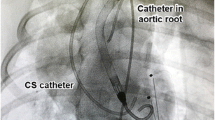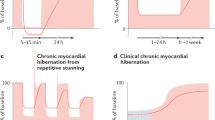Abstract
We tested the hypothesis that reduction of intramyocardial cyclic guanosine monophosphate (GMP) by methylene blue (MB) would improve mechanical dysfunction in stunned myocardium. Regional stunning was produced in nine open-chest anesthetized dogs by a 12-min left anterior descending coronary artery (LAD) occlusion. MB was infused into the LAD during reperfusion (1 mg/kg per min). Stunning reduced LAD force development, introduced a significant time delay between the onset of force and shortening (delay) and caused significant systolic bulging to occur. Stunning reduced systolic regional work (the integrated product of force and segment shortening during systole), but did not significantly alter regional oxygen consumption or cyclic GMP levels. MB decreased cyclic GMP (1.8 ± 0.2 to 0.9 ± 0.1 pmol/g) and increased peak force (36 ± 5 to 55 ± 10 g). However, MB increased delay (93.9 ± 18.4 to 233 ± 19 ms) and systolic bulging (5.9 ± 2.1% to 9.3 ± 2.8%) and further reduced systolic regional work (control: 4204 ± 933 g × mm/min; stunned: 2191 ± 542 g × mm/min; MB: 1153 ± 516 g × mm/min). MB increased regional myocardial oxygen consumption (7.4 ± 1.0 to 15.6 ± 2.7 ml O2/min per 100 g). These results suggest that depressed contractility, while present in myocardial stunning, is not the primary cause of mechanical dysfunction.
Similar content being viewed by others
References
Acad BA, Weiss HR (1989) Regional O2 consumption and coronary flow during beta adrenoceptor stimulation in reperfused canine myocardium. J Pharmacol Exp Ther 250:611–616
Ambrosio G, Jacobus W, Bergman CA, Weisman HF, Becker LC (1987) Preserved high energy phosphate metabolic reserve in globally “stunned” heart despite reduction of basal ATP content and contractility. J Mol Cell Cardiol 219:953–964
Balligand J, Kelly R, Marsden PA, Smith TW, Michel T (1993) Control of cardiac muscle cell function by an endogenous nitric oxide signaling system. Proc Natl Acad Sci USA 90:347–351
Becker LC, Levine JH, DiPaula AF, Guarnieri T, Aversano T (1986) Reversal of dysfunction in postischemic stunned myocardium by epinephrine and postextrasystolic potentiation. J Am Coll Cardiol 7:580–589
Bolli R, Zhu W, Myers ML, Hartley CJ, Roberts R (1985) Beta-adrenergic stimulation reverses post-ischemic myocardial dysfunction without producing subsequent functional deterioration. Am J Cardiol 56:964–968
Brady AB, Warren JB, Poole-Wilson P, Williams T, Harding SE (1993) Nitric oxide attenuates cardiac myocyte contraction. Am J Physiol 265:H176–H182
Chiu WC, Kedem J, Scholz PM, Weiss HR (1994) Regional asynchrony of segmental contraction may explain the “oxygen consumption paradox” in stunned myocardium. Basic Res Cardiol 89:149–62
Dean EN, Shlafer M, Nicklas JM (1987) The oxygen consumption paradox of “stunned myocardium” in dogs. Basic Res Cardiol 85:120–131
Guo X, Kedem J, Weiss HR, Tse J, Roitstein A, Scholz PM (1996) Effect of cyclic GMP reduction on regional myocardial mechanics and metabolism in experimental left ventricular hypertrophy. J Cardiovasc Pharmacol 27:392–400
Heusch G, Schafer S, Kroger K (1988) Recruitment of inotropic reserve in “stunned” myocardium by the cardiotonic agent AR-L 57. Basic Res Cardiol 83:602–610
Ito BR, Tate H, Kobayashi M, Schaper W (1987) Reversible injured, postischemic canine myocardium retains normal contractile reserve. Circ Res 61:834–846
Joselevitz-Goldman J, Upsher ME, Weiss HR (1990) Effects of propranolol on regional O2 supply and O2 consumption in reperfused dog myocardium. J Pharmacol Exp Ther 242:102–107
Kedem J, Guo X, Roitstein A, Weiss HR (1994) Local auxotonic myocardial force measurement in vivo (abstract). FASEB J 8:A590
Kedem J, Lee W, Weiss HR (1994) An experimental technique for quantitative determination of regional myocardial segment work in vivo. Ann Biomed Eng 22:58–65
Kedem J, Sonn J, Scheinowitz M, Weiss HR (1992) Effect of isoproterenol on regional myocardial segment work, O2 consumption and oxygen balance. Res Exp Med 192:323–334
Liedtke AJ, De Mainson L, Eggleston AM, Cohen LM, Nellis SH (1988) Changes in substrate metabolism and effects of excess fatty acids in reperfused myocardium. Circ Res 62:535–542
Lohmann SM, Fischmeister R, Walter U (1991) Signal transduction by cGMP in heart Basic Res Cardiol 86:503–514
Marczin J, Ryan US, Catravas JD (1992) Methylene blue inhibits nitrovasodilator- and endothelium-derived relaxing factor-induced cyclic GMP accumulation in cultured pulmonary arterial smooth muscle cells via generation of superoxide anion. J Pharmacol Exp Ther 263:170–179
Mery PF, Lohmann SM, Walter U, Fischmeister R (1991) Ca2+ current is regulated by cyclic GMP-dependent protein kinase in mammalian cardiac myocytes. Proc Natl Acad Sci USA 88:1197–1201
Michel T, Smith TW (1993) Nitric oxide synthases and cardiovascular signaling. Am J Cardiol 72:33C–38C
Morgan HE (1993) Cellular aspects of cardiac failure. Circulation 87 [Suppl IV]: IV4–IV6
Ono K, Trautwein W (1991) Potentiation by cyclic GMP of beta-adrenergic effect on Ca2+ current in guinea-pig ventricular cells. J Physiol (Lond) 443:387–404
Roitstein A, Kedem J, Cheinberg B, Weiss HR, Tse J, Scholz PM (1994) The effect of intracoronary nitroprusside on cyclic GMP and regional mechanics is altered in a canine model of left ventricular hypertrophy. J Surg Res 57:584–590
Shah AJ, Spurgeon HA, Sollott SJ, Talo A, Lakatta EG (1994) 8-Bromo-cGMP reduces the myofilament response to Ca2+ in intact cardiac myocytes. Circ Res 74: 970–978
Stahl LD, Weiss HR, Becker LC (1988) Myocardial oxygen consumption, oxygen supply/demand heterogeneity, and microvascular patency in regionally stunned myocardium. Circ Res 62:535–542
Tremblay J, Gerzer R, Hamet P (1988) Cyclic GMP in cell function. Adv Second Messenger Phosphoprotein Res 22:319–383
Author information
Authors and Affiliations
Rights and permissions
About this article
Cite this article
Naim, K.L., Weiss, H.R., Guo, X. et al. Local inotropic stimulation by methylene blue does not improve mechanical dysfunction due to myocardial stunning. Res. Exp. Med. 197, 23–35 (1997). https://doi.org/10.1007/s004330050052
Received:
Accepted:
Published:
Issue Date:
DOI: https://doi.org/10.1007/s004330050052




